Drawing of a water well - different options for different
Water wells, oddly enough, but this is a whole family of hydraulic structures, performing completely different tasks. Hence, a considerable arsenal of equipment - from submersible pumps and filters to overpressure damping systems.
Let us add to this that all sorts of innovative technologies based on very durable polymeric materials also contribute to the ever-expanding range of objects under consideration. In other words, the one who is going to deal with water wells, must first decide on its specific purpose, and then be sure to create a drawing of the future application.

And again you have to deal with the terms
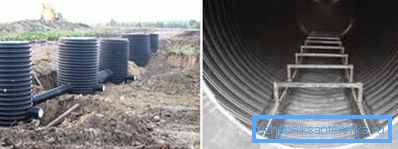
The two most important areas of application of such facilities:
- in the sewage system and water supply in urban environments;
- and, in the water supply system of a country house, when the well serves as a source of water and is included as the initial link in the overall system.
Plastic
In any case, the installation of the well requires considerable excavation and plastic comes to the rescue, which is very often happening in construction recently.
The use of plastic is:
- the use of a material that is very resistant to any impacts - from mechanical to chemical;
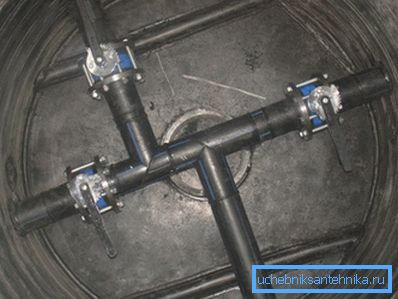
- the opportunity to deal with an ever-expanding range of parts that can satisfy any wishes and provide for any situations of use;
- the ability to create complex pipeline systems literally in a few hours without any welding and ancillary devices, when the work on the ground is finished, which is clearly demonstrated by the photo “A”:

- A - here until all the elements in a disassembled state;
- B - and this is a fully assembled well.
We present all the elements of such plastic assemblies, we only pay attention to the fact that the scale and range of parts can be much larger:
- A - cover;
- B - telescopic tube - this is directly from the incredible opportunities offered by new technologies; in essence, the telescope removes completely the question of taking care of the feverish adjustment of the height of the well to the depth of the aquifer or the docked line of pipes;

- C - telescopic cuff;
- D - the main pipe of polyvinyl chloride (PVC);
- E - bottom formation of the well, which significantly depends on its purpose.
Helpful advice! It is not by chance that PVC technologies are called revolutionary in the field of installation of plumbing systems. But their simplicity and many offers on the market can sometimes play an unkind joke. We advise you to deal in this area only with reputable organizations that have good experience in the construction of communications using PVC. In addition, be sure to explore all the available offers in terms of their cost - the price of the same components may vary by 1.5-2 times.
But closer to the diagrams and drawings
Continuing the topic of PVC, we offer as the first scheme the construction of precisely this material, which clearly demonstrates all the new features.
PVC well
The scheme of such a well is very mobile in its development and re-equipment, depending on the changing conditions of use:
- A is the neck;
- B - pipe with a diameter of 1-1.2 m for a well shaft;
- C - sealing cuff; in using such means of sealing, plastic will give “100 points ahead” to any other material, finally breaking this unfortunate saying: plumbing - the science of joints and connectors - they have always been a real headache for installers;

- D - a sealing ring;
- E - tray;
- F - sealing cuff.
Thus, on the basis of this assembly, you can create the following drawing of a sewage head damper well:
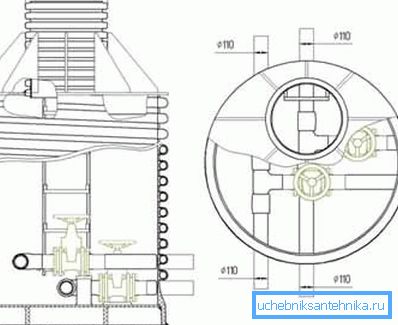
Notice here:
- additional stiffeners are used to strengthen the position of the tip;
- the system has an internal staircase, which removes the question of servicing the upper arch of the wide lower part;
- Two piping systems are used - the main and auxiliary ones to combat excessive pressure.
First complete drawing
As a first option, we offer the following, with a hidden lid:
- A - concrete base;
- B - base plate - such an organization is good if the well is used for sewage, water intake requires a more serious attitude and the use of at least quartz crumb;
- C - clay castle - if the well is in the country and outside the land, the castle will have to be made from above;
- D - ladder brackets;

- E - reinforced concrete or plastic rings, forming the skeleton structures;
- F - conical ring;
- G - ring of smaller diameter;
- H - support ring - and reinforced concrete and plastic allow you to choose a variety of diameters to create such structures;
- I - masonry can be used to adjust the height more accurately;
- J - concrete blind area;
- K - hatch - the perfect solution if you want to hide the well on the site.
Second option
This option is characterized by a thorough and rare method of forming the bottom of the well:
- A - sand preparation;
- B - layers of gravel;
- C - perforated drainage pipe;
- D - geotextiles, as a means of protection against moisture;
- E - sand filling of pipes;
- F - branch pipes;
- G - sand backfill along the core of the well;
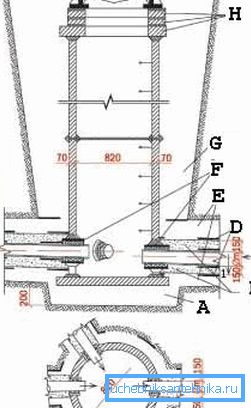
- H - additional rings;
- I - tip;
- J - cast iron hatch.
Third option
The third option already applies to wells that are built into the house's water supply system:
- A - well;
- B - submersible pump;
Helpful advice! We recommend using centrifugal pumps as submersible pumps. They are much more effective when working in comparison with vibratory ones, and, which is important for the structures under consideration, they are more careful with the surrounding design of the well.
- C - check valve;
- D - flexible hose;
- E - electric cable with anti-freeze and moisture protection system;
- F - cable; the proposed scheme makes it necessary to use this safety element, although there may be several options for solving this problem;
- G - pipeline, must be laid below the level of soil freezing;
- H - elektrokor - system of electrical protection about freezing (for details see the scheme below);
- I - flexible coupling;
- J - protective casing, isoproflex recommended;
- K - trench depth on the scheme 1.8 m;
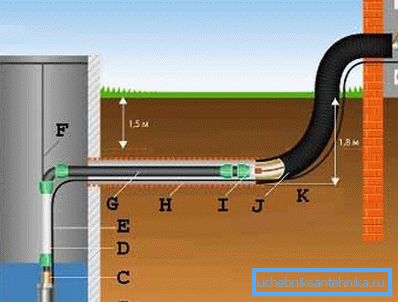
- L - automatic control and monitoring unit;
- M - network at 220/50.
Several auxiliary circuits
When it comes to such systems as water wells, it is impossible to avoid specifying some very important nodes:
- Firstly, the electric system of pipeline heating is very useful, consisting of the following elements:
- A - protective sheath;
- B - installation wire;

- C - heat insulation;
- D - heating section;
- E - the heated pipeline itself.
- Secondly, to protect against the accumulation of moisture along the side walls of the well, it is useful to organize inserts of cement filter elements that make three types:
- A - straight lines (arrows indicate the direction of moisture penetration inside the well);
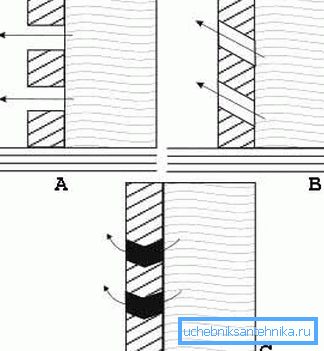
- B - oblique, note the rise in the direction of the inner cavity of the well, which is fundamentally important;
- C - conical.
- Thirdly, various methods and means can be used to clean the internal cavity of the well. In the end, there is always a scraper, lime and a ladder, but for large-scale works, a bucket created according to the following scheme is very useful;
- 1 - a pair of buckets;
- 2 - roller for winding the cable;
- 3 - roller finger;
- 4 - cable;
- 5 and 7 - M8 bolts, such as 6 in the drawing;
- 6 - thrust, in the design of their 4 pieces;

- 8 - ring for fixing the position of the bucket;
- 9 - traverse;
- 10 - compression spring;
- 11 - rod lock;
- 12 - eye;
- 13 - poluproshin;
- 14 - thin cable.
- Fourthly, the so-called Abyssinian may be a simpler version of the well, which rather resembles a well and, due to its “unpretentiousness”, is often built right in the basement of a house. The drawings of the Abyssinian well are very simple:
- A - check valve, without which not a single well can do;

- B - strainer welded to the pipe;
- C - turning cone - this is not able to solve the problem with water at great depths of aquifers, but with superficial water (up to 4 meters) it copes perfectly).
findings
The instructions for creating a water well and the type of its drawing are strongly dependent on the purpose of this structure. Of course, in different ways you can find a lot of common features. But there are significant differences, primarily in the organization of the bottom.
In order not to get confused in possible solutions, be sure to watch the additional video in this article, which will help you systematize all the knowledge.